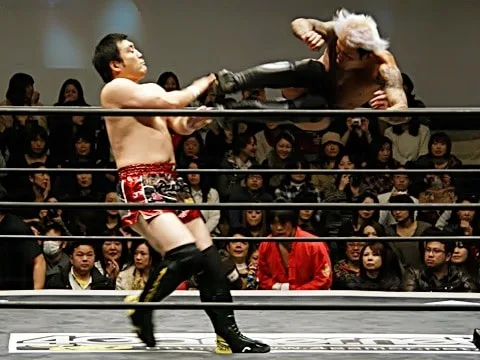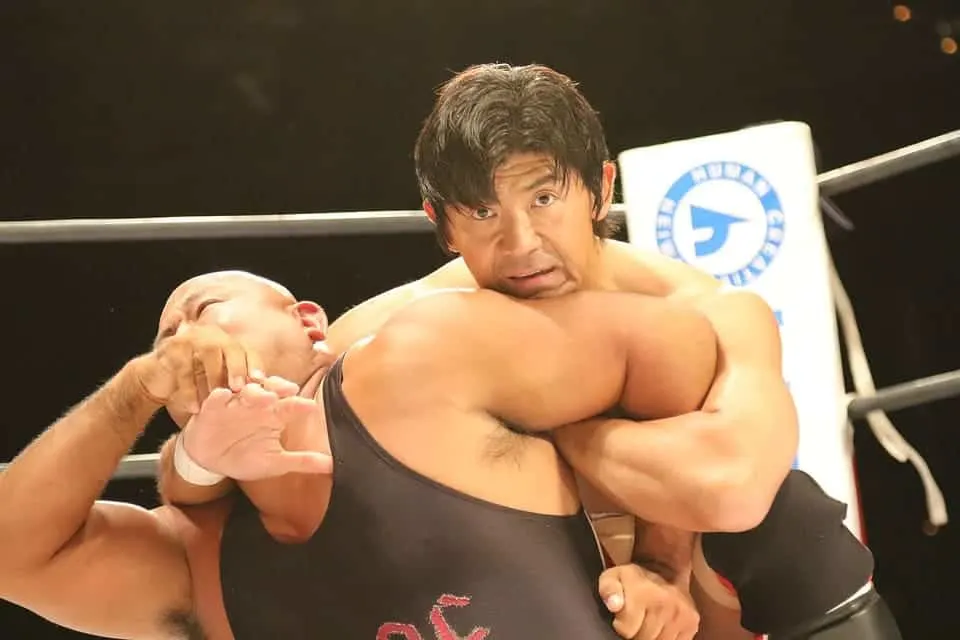
Shootfighting is a big subject matter that takes a good bit of explanation. The questions we hope to answer for you not only will be what shootfighting actually is. Rather, we’ll also let you know where it originates, the history behind it, those who famously used it, and much more.
You may not hear the term “shootfighting” spoken much these days. There’s a reason for that. A man by the name of Bart Vale bought the term and trademarked the term. He would become the co-founder of the International Shootfighting Association(ISFA). They’re pretty much the only people who use the term today.
You should first know that there are two forms of shootfighting. One is the actual martial art itself, which has tournaments governed by the aforementioned International Shootfighting Association. This martial art mostly grew in popularity in the early days of MMA yet it also became well-known in the world of professional wrestling too. In martial arts, you’ll see legit fights based on the style. For this reason, shootfighting is very real. In fact, some might claim that shootfighting was the original form of Mixed Martial Arts. Just like MMA, shootfighting mixes quite a lot of things in, but we’ll go over more of that below.
Second, shootfighting in pro-wrestling simply relates to what the word “shoot” means in pro-wrestling vernacular. Here, a “shoot” means something is real and not scripted or faked. Meaning, if you’re shootfighting…this was not part of the original, agreed-upon script.
Incidents like this have happened in matches, but usually only comes in the form of a “receipt.” This means that a wrestler is doing an equal shot back toward the opponent, to get him or her back for the legit shot they hit them with. Yet matches that are pretty much real have not been practiced in the United States since the early 1900s on a major stage.
Usually, shoots are uncommon in places like the WWE or American organizations today. Yet this is not the case in other countries.
Shootfighting Style is Influenced by Catch-Wrestling
Shootfighting is based on catch-wrestling, which is a hybrid style of wrestling overall.

You used to see these types of catch-wrestling players in major Fairs or Carnivals, where they’d be challenged by random people. Typically, they used a big, strong person for this. In the circus, where this was also in play, the “Strongman” might also work as the shootfighter of the group. However, that was not always the case, as there might be another bigger man (and sometimes woman) used specifically for the wrestling/shootfighting side.
The concept of catch-wrestling began in Britain but also made its way to the United States and Mexico.
The success of this style led to the development of Professional Wrestling. This, later on, became a scripted sport but used to be completely real and ALL based on catch wrestling content. Europeans STILL train their young pro-wrestlers in the catch-wrestling style well over 100 years since its invention too.
Catch Wrestling a.k.a Catch-As-Catch-Can:
Eventually, catch-wrestling led to the invention of many different moves. The problem is that there were many invented moves that worked well but were sadly outlawed from these tournaments. This became so common that it birthed a new sub-style under the catch-wrestling banner where there were fewer restrictions.
Underground fights happened all over the world, especially in The UK. This was a period in which unsanctioned or the underground fight game was perfectly okay, so long as you just did not do it in front of an officer. It was here where the new sub-style of catch wrestling was born. It came to be known as “Catch-As-Catch-Can.”
It comes from the idea that every hold or submission was legal. The only thing you could not do was aim for the eyes or attack the groin. Outside of this, as long as you could catch a wrestler in a lock or hold, you could do whatever to win.
Due to the style taking off in places like Europe & Japan, and eventually, Mexico & America, the concept of shootfighting came out of it. Later on, other disciplines would be added to it such as Muay Thai. That would result in shootfighting as a martial art being established completely.
Catch-Wrestling was no longer all shootfighters were known for by this point. With the introduction of Muay Thai, more holds and the clinch was established. Yet, more importantly, vicious strikes were legalized too.
The Most Notable Shootfighting Company: Pancrase:
Japan and several other Asian nations are responsible for most of the world’s martial arts. There are some that originate elsewhere but for the most part, Asia is the martial arts hub of the world. It should come as no surprise that a Japanese company was home to some of the most famous shootfighting tournaments ever.

Those fights happened in the most popular shootfighting territory in the world, Pancrase. It involved numerous people who would one day get into major MMA promotions.
Pancrase gets their name from Pankration, the former Greek Martial Art used in the original Olympic Games. They also involved a lot of the same styles as Pankration where pretty much anything was considered legal. Only a few things were outlawed, which fit shootfighting perfectly.
The original rules in Pancrase were as follows:
Closed-fisted punches are allowed, except to the head, and palm strikes to the head. Fighters must break a submission hold when the opponent reaches the ropes, but fighters who claim a rope break forfeit a point. Those who claim a specified number of rope breaks (between three and five) will be disqualified.” These rules were based on Pro-Wrestling concepts but they later changed their rules to fit MMA standards.
Shootwrestling’s Violent History In Japan
In professional wrestling, there are numerous styles. In Japan, the style they are known for is “Strong Style.” This is a type of wrestling that focuses more on strike and submissions over things like throws or “signature moves.” In Japan, wrestlers do not get away with doing a lot of fake or scripted fights. They want their wrestling to look good and come off as real as possible. This can lead to some problems.
There are numerous examples of this, but probably the best to mention was an incident that happened in 2017 to former New Japan Pro-Wrestling star, Katsuyori Shibata. During a match with Kazuchika Okada, the two were using violent strikes. Since Japanese wrestling has to look as real as possible, a lot of the strikes are “stiff.”
This means they are actually making contact, yet also hitting in a pretty hard way. The two were doing headbutts on each other during the match, with Okada landing numerous shots to the same area of Shibata’s head. The count was somewhere near 40 headbutts between the two, with Okada landing more.
After the match concluded, Shibata walked out of the ring and collapsed. He suffered what is known as a subdural hematoma, or a severe brain bleed. New Japan Pro-Wrestling(NJPW) banned headshots like this after but the damage was done. Luckily Shibata survived, but he nearly died simply due to this more violent style of wrestling that other companies might mark as a “shoot.”
This is just one of the cases of “shoot” shots in Japanese wrestling culture. Japan bases a lot of its wrestling on the shoot-style of wrestling, making it to where it has a massive connection to shootfighting overall.
Differences Between Shootfighting & Catch-Wrestling
While shootfighting is based on catch-wrestling, it is not entirely like it. Catch Wrestling is a hybrid wrestling style but it’s comprised completely of holds and submissions. There are no strikes and there are several rules in organized competition.
In shootfighting, there are very few rules. Meaning, you could get away with far more holds or submissions that would get you disqualified in a catch-wrestling tournament.
Not only that, but the introduction of strikes made shootfighting completely different. In catch-wrestling, strikes are not legal. You also win by getting a pin or tap-out. This truly comes down to the specific rules of a tournament. Meanwhile, in shootfighting….pins are not involved. You can still win by submission (tap-out), but you can also win by a Knockout.
Catch Wrestling also has tournaments with people of multiple weight classes on a professional level. Shootfighting only has one professional division currently, the Heavyweight. They base their Heavyweight Division on all people above 200lbs, however. All others are part of the amateur competition circuit.
Differences Between Shootfighting & MMA
The International Shootfighting Association(ISFA) is really the only place for professional shootfighting tournaments, yet their rules are not far off the rules seen in overall shootfighting. For the ISFA, pro fights run 30 minutes non-stop. They have no round breaks at all. Amateur fights run 10 minutes completely, also without round breaks.
Fighters are allowed to kick, knee, and even elbow ANY part of the body except the groin area in shootfighting. They are also allowed to headbutt and punch to the body. However, they do not wear gloves to free them up to wrestle, which is why they are not allowed to use open-palm strikes to the head. Yet slaps and closed fist punches are legalized.
In MMA, there are many strikes that are not legal. They also wear gloves so most shots to the head are legal, but specific elbows on the ground are not. Yet in shootfighting, all ground shots are legal.
In Shootfighting, any form of takedown or throw is completely legal too, and you can even hit an opponent who is already down on the ground. All joint locks and chokes are 100% legal, even chokes to the side of the neck. Of course, there are some fouls such as the punch issue and groin hit. Yet they also foul those that use eye-gouging and strikes against the windpipe.
Rules in Shootfighting:
A fight is won in shootfighting when a fighter is knocked out for a ten count, just like boxing. However, fights also end if a person is knocked down in any way as well as if they are forced to submit. Fighters can grab a rope to break a submission hold during a fight, but it counts as a 1/3 knockdown. Grabbing the rope 15 times in a fight is an automatic loss.
However, if no winner is decided in the full 30 minutes of a pro-fight, the fight overall is considered a draw.
Shootfighting takes place inside a normal wrestling ring and not an octagon like most MMA promotions use.
Although Pancrase had been the most popular shootfighting company for years, they changed up their rules years back. They now utilize the “Unified Rules of Mixed Martial Arts.” Which basically means they are an MMA company now, no longer a Shootfighting company.
That said, do not get them confused today with a shootfighting organization due to this change.
Notable Shootfighting Competitors
There are several, and we mean several people who have been involved in shootfighting tournaments. Some of them went on to become major names in the world of MMA. Meanwhile, others went into pro-wrestling or never made it out of the shootfighting game.
Some of the names you might know are people like Nathan Marquardt, Minoru Suzuki, Josh Barnett, Bas Rutten, Frank Shamrock, Ken Shamrock, and Carlos Condit.

Most of the men mentioned above were champions at some point in the world of shootfighting, in particular Pancrase. Ken Shamrock was the first King of Pancrase Champion. Shamrock actually began his major fight career in Pancrase, becoming a legit top fighter well before the invention of the UFC. He would eventually go back and forth between Pancrase and UFC before he signed on with the WWF(E). His King of Pancrase Tournament win in 1994 was impressive but most believe his brother, Frank, was better.
Frank Shamrock was considered the pound-for-pound best fighter in the world at one point. His work in Pancrase was immense too. He also won the King of Pancrase Championship, doing so 2 years after Ken did it. He’d later go on to make history in the UFC too.
Minoru Suzuki is now a professional wrestler who has been successful throughout Japan. Yet he had around 50 shootfighting bouts, most with Pancrase, from 1993 to 2002. He won the King of Pancrase Openweight Championship in 1995 then had 2 successful defenses.
Josh Barnett also got into the world of professional wrestling yet also went back and forth between it and MMA. Before this, he was a shootfighting champion with Pancrase. He won the Pancrase Openweight Championship, defended it twice, and the title was retired, Making Barnett the last to ever hold it. He’d also become a UFC Heavyweight Champion later too.
Nathan Marquardt and Bas Rutten might be the most successful shootfighters. Nathan was a 3-time Pancrase Middleweight Champion, he was also the first to win it. Bas Rutten won the King of Pancrase Openweight Title 3 times and became the Undisputed, Unified KOP Champ too. He had 2 successful defenses of the title as well. He too won the UFC Heavyweight Title.
Shootfighting Techniques
There are several shootfighting techniques that are seen in multiple different martial arts disciplines. Therefore, it would be tough to claim that they have techniques unique just to their sport. However, due to the legality of so much, shootfighting teaches many different holds or submissions that would be considered incredibly dangerous and wouldn’t be allowed in most martial arts tournaments.
This is why pretty much every street fight would likely involve things you’d see in shootfighting, minus groin shots & eye-gouging. The issue with pinning down any specific techniques here is that they borrow from every other martial art. Specifically, we mentioned their connection to catch wrestling, catch-as-catch-can, and Muay Thai. Yet they also borrow a lot from Kenpo.
Of course, American Kenpo is basically modern-day street fighting. There are several other styles that lean toward other specified martial arts, such as China’s version as well as the Japanese. Many of those tend to use specific bases, such as the five animal Chaun Fa techniques. Japan adds in the Buddhism martial arts styles and bases too.
Therefore, depending on what Kempo style you add in shootfighting, you’ll get specific techniques unique to those styles.
Shootfighting Schools
It’s not exactly hard to find shootfighting schools across the world, as there has been some version of it all over the place for decades. In America, the International Shootfighting Association(ISFA) happens to have classes open to all. They have specific schools or those they endorse all over the United States. You can check those schools out here.
However, if you’re not in America and still want to take classes….the ISA also has a school they endorse in India. Yet you can also find several that teach base versions of it such as wrestling, Kenpo, Muay Thai, etc. You do not need to only train in shootfighting to know how to be a shootfighter. It might even be best to actually train in other martial arts before you go into shootfighting.
This way, you know a good bit about the others and the dangers they present. This could make you respect shootfighting even more and know your limits. Overall, you can simply learn by watching online these days too. Many places such as the ISA also have videos online to watch. On top of this, schools sometimes do direct satellite campuses or offer videos. Ultimately, there are many options.
